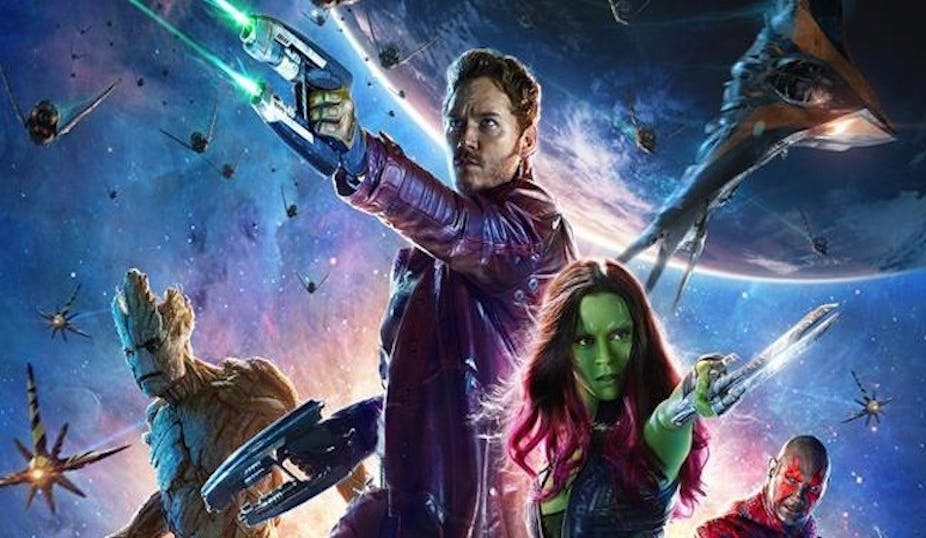A beautiful assassin. A superstrong thug. A star-lost child of the ‘80s. A sentient tree. A gun-toting raccoon. Meet the morally gray protagonists of Marvel’s Guardians of the Galaxy, the film that raked in $770 million at the box office this past summer and was just released on DVD.
Guardians, I’d like you to meet 20th-century mythology theorist Joseph Campbell. Trust me, you’ll have a lot to talk about.
…Oh, what’s that? You already know Mr. Campbell? Ah, that’s right, I’d forgotten: you beat the stuffing out of his heroic monomyth in your movie this year.
For those unfamiliar with the term: Campbell’s monomyth, also known as the “Hero’s Quest” or “Hero’s Journey,” is a narrative pattern derived from his extensive analysis of myths and stories from all around the world. In his 1949 book The Hero with a Thousand Faces, Campbell outlines the pattern that nearly every “heroic” protagonist, going all the way back to ancient times, follows.
A hero ventures forth from the world of common day into a region of supernatural wonder: fabulous forces are encountered and a decisive victory is won: the hero comes back from this mysterious adventure with the power to bestow boons on his fellow man.
In other words, the protagonist is placed outside of his or her comfort zone, and, after toiling through various obstacles and setbacks, emerges to beat the bad guys and change the world for the better.

Since the trailer of its newest installment was released last week, think of the original Star Wars as an example. George Lucas had Campbell in mind when he created Luke Skywalker, farmboy turned rebel hero. Lucas even paid attention to the finer points of Campbell’s model, giving Luke a teacher (Obi-Wan), helpers (Han Solo, the droids), a magic talisman or weapon (the light-saber), and, most importantly, a moment that Campbell calls “the Abyss.”
It’s this Abyss – also known as “The Belly of the Whale” – that’s the low point in the monomythic cycle and vital to understanding what’s so notable about Guardians of the Galaxy. In the original Star Wars, Luke Skywalker experiences – all things considered – an “easy” low point: he’s sucked underwater in the Death Star trash compactor. In The Empire Strikes Back, things get a bit thornier: he gets his whole hand chopped off (rumored to be a plot point in JJ Abrams’s The Force Awakens) and plummets from Cloud City. Basically, if a hero doesn’t face an actual death, he or she has to (at least) deal with a metaphorical death before returning as a stronger, savvier version of himself.
But where was the Abyss moment in Guardians of the Galaxy? Was it when young Peter Quill loses his mother and is taken by aliens? Or, wait – maybe it’s when he’s thrown into that space prison and escapes? There’s also that moment when his team is nearly killed by an explosion in the Collector’s establishment. And Quill is all-but-dead when he leaves the safety of his ship to freeze and suffocate in exposed space while selflessly saving his teammate Gamora. And who can forget the scene when he is practically torn apart by wielding the Infinity Stone?
It’s as if Quill and his Guardians are running in loops around Campbell’s monomyth. Or, even better, the movie-makers are flagrantly disregarding it. They’re nearly satirizing it.
If audiences step back a bit, it’s easier to see how Guardians of the Galaxy might be a satire of the classic hero tradition. Villains are constantly interrupted mid-maniacal monologue, elaborate plans are impulsively overturned, and Quill, the movie’s closest thing to a hero, challenges the film’s protagonist to a dance-off. (Of course, there’s also the fact that two of the main characters are a tree and a raccoon!)
This is not to write off Guardians of the Galaxy and claim it’s a goof on Campbell’s model. Instead, it could be seen as a reaction to just how predictable, how tired, and even how broken the monomyth is today. The Guardians, remember, are just as much rogues as they are good guys. As Quill asks his team of misfits, “What should we do next: Something good, something bad? Bit of both?”
What Guardians of the Galaxy will do next – presumably in their Summer 2016 sequel – is continue to challenge our modern notions of heroism. Campbell’s monomyth was proposed just after World War II, at the dawn of the Cold War. It was a time when, in popular culture, the distinctions between heroes and villains were far more explicit.
Today, Quill and company are being presented to movie-going audiences at a time when when we’re distancing ourselves from old models – when we sorely crave a new pattern. The pure hero, the “white hat” of the old Westerns, is largely lost to us. Brilliant actors like Robin Williams and Phillip Seymour Hoffman are done in by their own personal ghosts, musicians like Amy Winehouse and Whitney Houston succumb to their addictions, and politicians – like the four Illinois governors who have been sent to prison – continue to disappoint. The Dark Knight perhaps said it best: “You either die a hero or you live long enough to see yourself become the villain.”
The monomyth is making its final orbit. Heroes are so yesterday. Welcome, instead, to the tomorrow of the Guardians: characters who are a little good, a little bad, and more unpredictable than ever.

